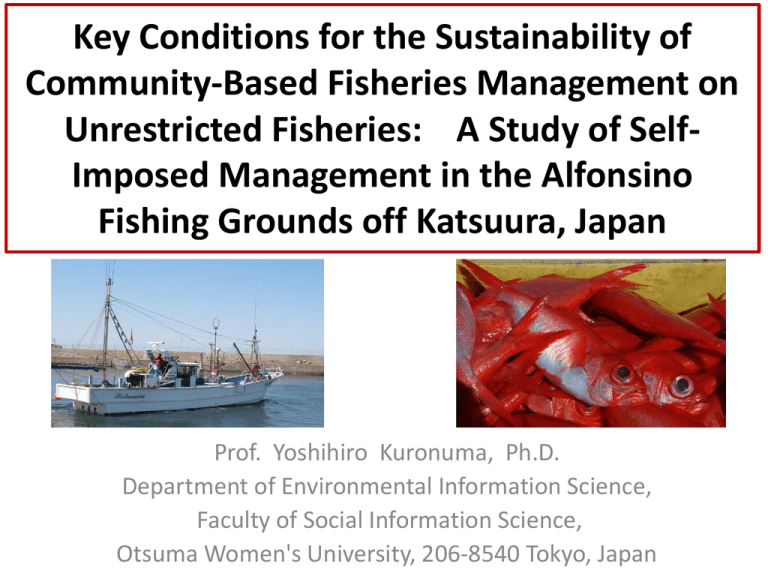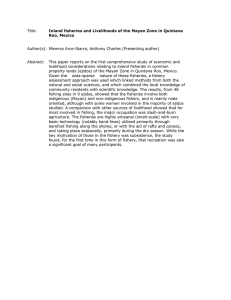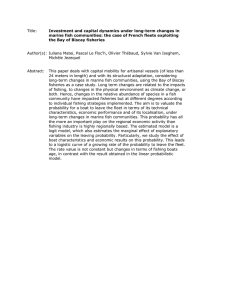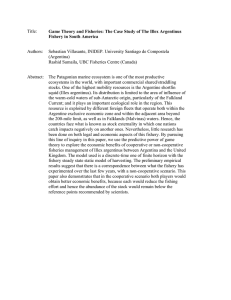Key Conditions for the Sustainability of Community-Based Fisheries Management on
advertisement

Key Conditions for the Sustainability of Community-Based Fisheries Management on Unrestricted Fisheries: A Study of SelfImposed Management in the Alfonsino Fishing Grounds off Katsuura, Japan Prof. Yoshihiro Kuronuma, Ph.D. Department of Environmental Information Science, Faculty of Social Information Science, Otsuma Women's University, 206-8540 Tokyo, Japan BACKGROUND OF THE FISHERY ・Target Species: Alfonsino (Beryx splendens) → Migratory Nature ・Fishing Ground: Off-Katsuura Alfonsino Fishing Ground ・Fishery: Vertical Line Fishery → Legally Unrestricted Fisheries ・Fishing Boats: mainly around 5 tonnes ・Numbers of Boats: around 250 boats in 2014 (Off-Katsuura F.G.) ・Catch: around 855 tonnes per year (average of 2009-13) ・Operation Pattern: Multispecies Fisheries ・Management Body: Chiba Prefecture Small- type Coastal Fishing Vessel Fishery Cooperative(STCC: formed by 12 regional fisheries cooperatives in 1966) (around 380boats in 2014 ) Brief History of the STCC and Its Self-management 1949-1965 (Early Formation Period of the STCC) ⇒ origin of the STCC was established in 1949 for collective negotiation of the compensation for fishing grounds used as drilling area by the USA Air Force 1966-1977(Formation Period of the Self-imposed Fishing Ground Management) ⇒ The STCC was legally approved as the cooperative by the Chiba Prefectural Government in 1966, and the Division of Alfonsino Fishery was formally established under the STCC in 1977 1978-1993 (Establishment Period of the Self-imposed Management) ⇒ Self-imposed regulation was formally ratified by the STCC in 1978, and Recognition of fisheries management by the Fisheries Agency of Japanese Government in 1992 ⇒ catching alfonsino and releasing it after marking for an investigation of migratory pattern since 1984 (in total, 21,353 alfonsino were marked and released up to 2013 in off-Katsuura fishing ground) ⇒ “Guideline on marine living resource management promotion ” were formulated by Chiba prefectural government in 1993 as a external support for the STCC 1994-Present (Formation Period of Self-imposed Resource Stock Management ) ⇒ re-liberation of 1-age fish (1994~2003:less than 22cm, 2004~Present: less than 25cm) was implemented by the STCC, and restraint on transaction of 1-age fish in the fish market ⇒ establishment of “fishermen’s committee of alfonsino fisheries resource management in Chiba” in 1995 ⇒ formulation of “Resource management plan of Shin-Katsuura Fishery Cooperative ” in 2011 ⇒ alfonsino resource estimation by cooperation among Fishery Agency and related prefectures between 2014 and 2015, and resource management measures would be examined between2015 and 2016 2011-Present (Formation Period of Stabilization of Income on Fisheries Business Management) ⇒ a resource management plan together with fisheries risk management plan under fraternal insurance of the fishery (adaptive fisheries management system under co-management) Main Factors For The Self-Management of Alfonsino Fisheries 1)External Factor Several disputes over fishing grounds among different fisheries have resulted several agreements on fishing grounds utilization. ↓ resulting ‘exclusive’ use of off-Katsuura fishing ground for protection of alfonsino resource by the local fishing community of the STCC for alfonsino fishery ↓ protection of the fishing ground from another type of fisheries 2)Internal Factor The order of fishing operation in the fishing ground was established with Amatsu and Kominato (two local communities) playing the central role. ↓ establishment of the self-imposed order of fishing operation by the STCC ↑ community based fishery as a key element Main Factors For the Adaptive Fisheries Co-Management 1) Alfonsino Fisheries → self-imposed management since 1960’s 2) Local Fisheries Cooperatives Markets → self-imposed marketing, such as ・removal of size below 18cm alfonsino at Amatsu Fish Market since early 1990’s, and ・minimum size of 25cm(less than 200g) were introduced in 2004 among related Chiba markets, and ・seven blanches of local markets function were closed for an intensive use of Katsuura fish market in 2010 3) National and Prefectural Governments → provide supporting system, such as ・“Guideline on Marine Living Resource Management Promotion ” were formulated by Chiba prefectural government in 1993, and ・establishment of “Fishermen’s Committee of Alfonsino Fisheries Resource Management in Chiba” in 1995, and ・fisheries risk management plan under new fraternal insurance of the fishery together with Japan Fisheries Cooperatives since 2011. ↓ ↓ ↓ Formation of adaptive fisheries co-management system ABOUT TWENTY YEARS AGO ・・・ 1) “Key conditions for community based fisheries management : a case study on selfimposed management in Alfonsino fishing ground off Katsuura, Japan” poster presented at the 2nd World Fisheries Congress , July 1996, Brisbane, Australia 2) “JAPAN: PARTⅡ-7 Case study of fishing ground management in unrestricted fisheries: Self-imposed management of vertical long line fishery in Alfonsino fishing ground off Katsuura, Chiba prefecture.” Towards Sustainable Fisheries: Issue Papers. OECD/GD(97)54, pp.357-369, 1997 OECD, Paris. 3) Others: Investigation report to JF (March 1995, pp30-47・in Japanese), and oral presentation at the 43rd Japan Fisheries Economics Association (May,1996・in Japanese) , etc. SEVERAL CONDITIONS WERE DERIVED FROM THESE STUDIES • External Necessary Condition ⇒ ‘exclusive’ use of the fishing ground by the local alfonsino fishing community of the STCC as the result of mutural agreement/adjustment among different fisheries. • Internal Necessary Condition ⇒ establishment of the order of fishing operation based on the mutural agreement/adjustment among the members of the STCC • Key Element for the Above-Conditions ⇒ a communal solidarity and social milieu to protect the fisheries and fishing ground together with a gentlemen’s order among the local fishermen After Twenty Years Later ・・・ ⇒ Some Differences • Additional Self-imposed Rules: such as, 7hrs/day operation in 1993 → 4hrs/day operation in 2013 no operation on 1st & 3rd Sat. → all Sat. since 1998 • Increasing Ratio of Alfonsino Fishing Operation Among STCCMembers (43.3% in 1993→ 68.2% in 2012) • Core part of management are still self-imposed management based on their community; however, comanagement factors has increased its importance for adaptive fisheries management GENERAL CONCLUSION FROM THIS COMPARATIVE STUDY • An effective management of an open-access fishery, even targeting a migratory nature of fish, would be possible based on community based self-management together with adaptive comanagement system. • This study does not still indicate a conclusive evidence for an efficient management from a neoclassical economics standpoint, but only effective management under the constraint of a group adaptive management with some governmental supports. 1994/11/20 2014/06/15 2014/06/15 1994/11/20 2014/06/15 1994/11/20 2014/05/18 1994/11/17 2014/05/25 1994/11/17 TO BE CONTINUED IN YEAR 2034 !? 2014/06/15




